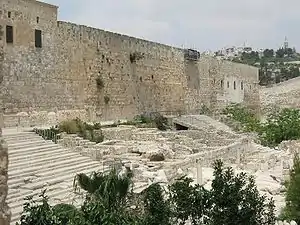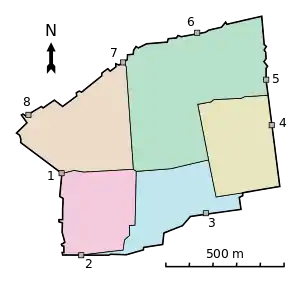Güney Duvarı
Güney Duvarı (İbranice: הכותל הדרומי, romanize: HaKotel HaDromi), Kudüs'teki Tapınak Dağı'nın ve İkinci Tapınağın güney ucunda bulunan duvardır. Kral Herod'un Tapınak Dağı platformunu güneydeki Ofel'e doğru genişletmesi sırasında inşa edildi.
| Kudüs |
|---|
| Serinin bir kısmı |
-Aerial-Temple_Mount-(south_exposure).jpg.webp) |
| * Tarih |
|
| Kuşatmalar |
| Yerler |
|
* İnsanlar
|
|
| Statüsü |
|

Tapınak Dağı'nın güneyinde kalan Güney Duvarı'nın doğu kısmı
İnşaatı
Güney Duvarı'nın uzunluğu 281 metredir; hatta Yahudi tarihçi Josephus bunu bir furlog uzunluğuna eşit olarak değerlendirmiştir.[1] Zeytin Dağı'nın üzerinde durmaktadır ve Herod'un Tapınak Dağı'nın güney uzantısında olan biri tarafından rahatlıkla görülebilmektedir.
Kaynakça
- Josephus, Antiquities (15.11.3; XV.415–416), who described the dimensions of the Temple Mount in the following terms (apparently not including the extension made to the Temple Mount): “This hill was walled all round, and in compass four furlongs; [the distance of] each angle containing in length a furlong (Gr. stadion).” Compare Mishnah Middot 2:1 which states that the Temple Mount measured five-hundred cubits (Heb. amah) by five-hundred cubits. If it can be ascertained that Josephus' stadion is equivalent to the 500 cubits mentioned in the Mishnah, and being that the Southern Wall measured 281 meters, this would place each cubit (Heb. amah) at 56.205 cm. Rabbi Saadia Gaon, on the other hand, holds that a stadion was equivalent to only 470 cubits (v. Uziel Fuchs, "Millot HaMishnah" by R. Saadia Gaon — the First Commentary to the Mishnah, Sidra: A Journal for the Study of Rabbinic Literature, pub. Bar-Ilan University Press (2014), p. 66), in which case , each cubit was 59.792 cm, close to the 60 cm. cubit espoused by the Chazon-Ish.
This article is issued from Wikipedia. The text is licensed under Creative Commons - Attribution - Sharealike. Additional terms may apply for the media files.
